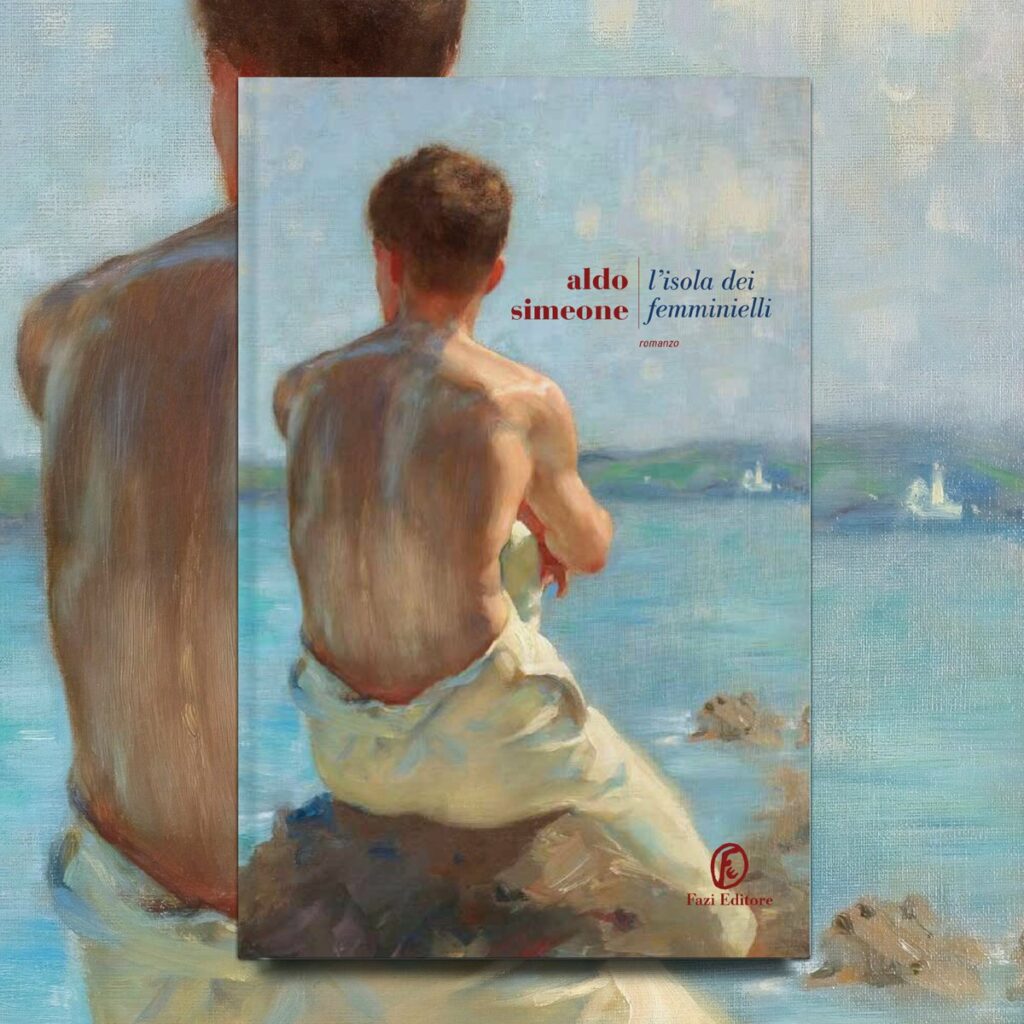The island of the feminielli. Stories of homosexuals to confinement

Dialogue byKatya ParenteWith Aldo Simeone
When I came across this book, another immediately came to my mind, discovered thanks to the course of Professor Maya De Leo: "The enemy of the new man. Homosexuality in the fascist totalitarian experiment "ofLorenzo Benadusi (Feltrinelli, 2005). But, if that was an essay, the book we deal with today "The island of the feminielli"(Fazi Editore, 2024) is a work of narrative, by its own nature therefore certainly less" cold "and emotionally more engaging. We therefore welcome the author of the book, Aldo Simeone.
You tell us, for those few who didn't know, who are the feminielli?
"Femminiello" is, in Neapolitan, the homosexual. On the contrary: the effective and disguised homosexual. Often, even, the disguised homosexual is understood that is given to prostitution. It is a derogatory term. Because, in the male chauvinist and patriarchal mentality, "feminiello", "percuse" (in Sicilian), "pederasta" is not every homosexual: it is only the passive gay. The "active" are considered "males", and for this reason tolerated with an indulgent blame. On the contrary, feminielli appear against nature: either purple or sick.
The same moralists of the mid -twentieth century did not know how to decide between the two accusations: whether to consider homosexuality a dissolute conduct, or a physiological and even contagious evil. In any case, for fascism the pederasty was to be repressed. Thus, in the 1930s, the dictatorship now became totalitarianism conceived a place of confinement in which to segregate the pederasts. It was the island of San Domino, in the Tremiti archipelago, which was for this reason it was called "The Island of the Feminates".
Why did you call the main character of the book as you?
In fact it is a significant coincidence. Also because it is the only non -registry name in the novel. "Aldo" is one of the few witnesses that Goretti and Giartosio, authors of the essay "The city and the island", manage to trace and interview seventy years after the events of San Domino. They are the ones who call him this way, to protect his identity. Well: it is the only Tuscan confined on the island.
E proprio di una voce come la sua avevo bisogno per raccontare questa storia: una lingua che potessi sentire mia, anche nelle espressioni idiomatiche e vernacolari; una testimonianza completa e in prospettiva, dato che Aldo è fra i pochi sopravvissuti e per altro non rinnega il proprio passato, da cui però prende le distanze (la sua prima affermazione è: “io non ero buco”, cioè “omosessuale”). Il fatto che il suo nome – benché d’invenzione – sia anche il mio me lo ha fatto sentire ancora più vicino, mi ha permesso di identificarmi nel vero senso della parola. Si aggiunga il fatto che la versione originaria di questo romanzo era in prima persona. Avevo bisogno di abbattere ogni distanza prudenziale, di concedermi a una totale compromissione.
Come ti sei documentato?
La fonte prima e fondamentale per ricostruire la vicenda l’ho già menzionata: è il saggio di Goretti e Giartosio “La città e l’isola”, edito da Donzelli nel 2006 e recentemente ristampato. Ne ho avuto notizia leggendo, nel dicembre 2013, un articolo su «Focus storia». Di bibliografia in bibliografia, ho potuto quindi recuperare e leggere tutto quanto (almeno credo) edito sul confino omosessuale durante il ventennio fascista. La lista in verità è tristemente corta. Poco, troppo poco, su un argomento tutt’altro che marginale della nostra storia nazionale.
Ma l’aiuto più prezioso nella ricerca mi è arrivato – ancora una volta – da un incontro fortuito: quello con la fotografa Luana Rigolli, che proprio mentre io mi accingevo a concepire il romanzo stava completando il suo reportage fotografico “L’isola degli arrusi”. È un lavoro straordinario, che riporta alla luce i volti dei confinati siciliani, le loro schede segnaletiche, i luoghi di provenienza e di confinamento, i verbali, il regolamento… Mi ha reso possibile non solo immaginare i personaggi, ma conoscerli davvero.
L’adagio “la libertà è uno stato d’animo” sembra guidare la comunità dell’isola. Secondo te le persone LGBTQ+ sono ancora ghettizzate, anche se in maniera diversa?
Senza ombra di dubbio. In varie parti del mondo non sono solo ghettizzate, ma anche segregate, costrette all’invisibilità o alla negazione di sé, umiliate, incarcerate e addirittura uccise. Ma anche dove vige – da quasi ottant’anni – la tutela dei diritti umani universali, si continuano a praticare forme di discriminazione in base all’orientamento sessuale. In Italia, le persone LGBTQ+ sono ancora escluse da alcuni diritti basilari, per esempio avere una famiglia, adottare dei figli. Non solo: ogni volta che si perpetuano stereotipi di genere (anche quelli che possono sembrare i più innocenti), si alimenta il falso mito di una mascolinità e una femminilità unici e monolitici.
Not to mention the most explicit discrimination: parents who do not accept gay children; peers who ironize, insult, bully; Public relevance characters who dust off anachronistic patriarchal schemes. The same shame of oneself, which unfortunately still many LGBTQ+ people try, is the testimony of a ghettoization still rooted in the mentality, in languages, in the costumes. Finally, let's not forget: freedom is not only a state of mind, it is also and above all a condition that must be guaranteed to others and that others must guarantee us: a commitment of everyone to disengage (concept still so difficult and misunderstood), to set a limit not to be valid, to grant space.
This is not your first literary test ...
I made his debut in 2019 with "For whom is the night", a novel rather different from "The Island of the Femminielli". I have developed other themes and reasons that are very dear to me and on which I will certainly return: in particular, a dimension of ambiguity between the fantastic and the reality. But there are also - as is inevitable - various points of contact. For example, the presence of history (with a capital), which enters the leg tense in history (with the tiny). The relationship between the individual affair and the collective experience cannot conceive it as harmonious, but always conflicting. An attack. The "external" that bursts into the private sphere and purple: forces the characters to take a position, act. And with this we return to the theme of freedom ...
What are you working for now?
"The island of the feminielli" is not my second novel. I wrote another before, which I decided to freeze because I was not convinced of the opportunity to present it after "for those who are the night". But I don't want to keep it closed in a drawer. I have in mind to go back on and publish it. Perhaps, as a third work it can work. Moreover, the second test is always the most difficult, because it confronts a expectation: confirmation or denies it. The risk, in my case, was to introduce myself as a writer "for boys".
Nothing bad, if this were the case. But “For whom the night is"It is not a children's book, let alone the second novel, although both insist on the ridge between gender fiction and its overcoming. Indeed, his disavowal. I like this game of forms that break, of grafting, hybridizations, because it allows you to work on the reader's expectations. In the near future, I have in mind to do it on one of the most codified genre ever: yellow. A sketch of history has been tickling me for some time. Above all, some characters. I see them, I hear them: they ask for the word.
As, moreover, they make the protagonists of every story - when they give it a voice, then they speak on their own, they take the author by the hand and lead him where they want.
We await the next literary proof of Aldo, entering in the role and life of his homonymous man on a small island for a "sin" that should never be considered such: the courage to be oneself.






